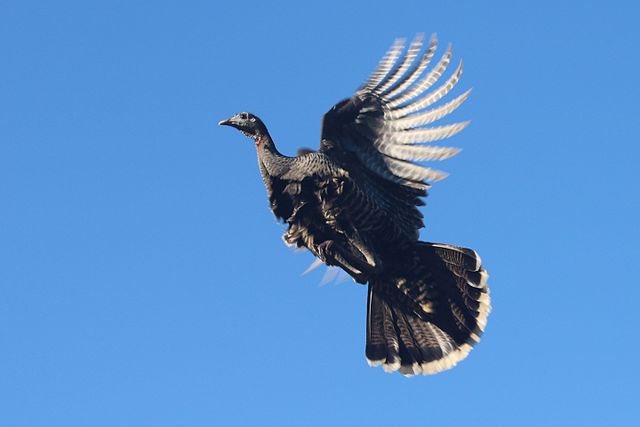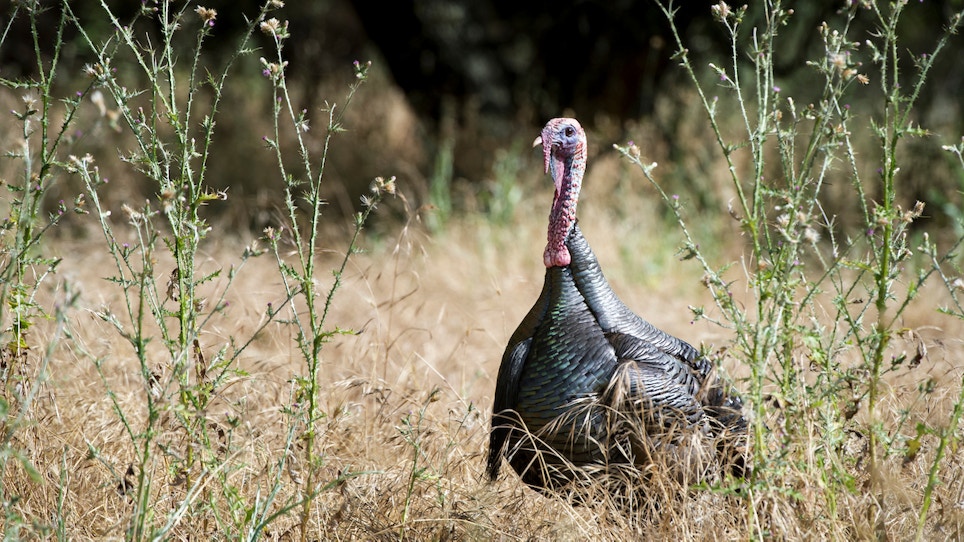Wild turkey, subspecies: Rio Grande. Photo: Nick Trehearne
Wild turkeys can fly, while domesticated turkeys can’t. Except for a few feeble flaps, domesticated turkeys are limited by their size. Like most domestic livestock, this domesticated bird is bred to produce maximum amounts of protein via meaty sections of their body. Take one look at the breast of your next holiday turkey and you’ll see this bred-in trait. Meanwhile, wild turkeys retain a sleek body makeup, a wily nature and an instinctive escape response that sometimes includes flight.
Ken Dial, a professor of biology at the University of Montana, describes turkey flight elegantly in a November 25, 2013, “Washington Post” article. His specialty is animal flight and turkeys are unique in that aspect as Dial relates in the article.
“Turkeys spend 99.999 percent of their lives on their legs, so they’re built a little like a hoofed animal,” says Dial. “Their bodies are squashed laterally, with their knees pulled in and their legs splayed. The legs have excellent circulation to supply fuel for sustained running.”
Related: Wild turkey basics
How fast are wild turkeys?

Photo: By Grendelkhan - Own work, CC BY-SA 4.0
In an August 8, 2016, “Scientific American” article by Dawn Starin it’s reported that wild turkeys are actually speedsters both on terra firma and in flight.
“They’re fast, reaching a running speed of 25 miles per hour – just a bit less than Usain Bolt’s top speed. And though they only fly for short distances, their flight speed can reach 60 miles per hour.”
That fast speed on the ground helps them evade danger quickly when pursued in forest or field. And if flight is needed a wild turkey’s powerful legs can launch it to airborne safety as well. If you’ve ever watched a wild turkey take flight you see two different styles. Some run to first escape and then to predicate the launch. Others simply squat and thrust themselves airborne with the help of their large wings. They have no issue taking flight from a trotting or standing position.
According to Dial, a turkey’s wings are built for rapid flight and you can see that in their “cupped” design. This allows them to get away from a predator with a burst of leg energy followed by rapid wingbeats.
How long can a wild turkey stay airborne?
Unfortunately, even though these 20-pound-plus birds can shoot for the heavens, their actual flight time is short. Dial notes that the breast muscles, used for flight, only evolved for short flights. This is supported by how the body only fuels a turkey for brief periods with its own chemical according to Dial.
“Glycogen, the energy-carrying chemical that feeds a turkey’s breast during flight, ‘is used up very quickly.’ It’s something like nitro fuel for a dragster.”
So how far can these bombshell birds fly?
Most firsthand witnesses report of flights extending 100 yards or less. That may be the case in heavily forested areas, but in my Western backyard I’ve witnessed Merriam’s launching, flapping and sailing for several hundred yards to cross large canyons when in escape mode.
Despite the occasional lengthy flight the wild turkey isn’t set up for soaring or a long migrating flight. They’ll dash away with leg power first and foremost. If that doesn’t work there’s always the option of flight. Sorry Mr. Butterball. You’re grounded and headed to a grocery aisle in the very near future.
Related: Top 10 wild turkey facts






